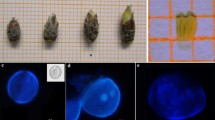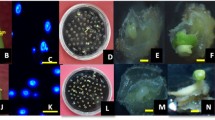Abstract
The inadequate response of Indica rice (Oryza sativa L.) to anther culture hinders the utility of this technique for rice crop improvement. This study focused on intensifying the in vitro anther response of selected varieties from Sri Lankan germplasm by precisely targeting the most effective maturity stage of microspores for culture. Analysis of five varieties responsive to anther culture (“At 303”, “Bw 272-6B”, “Dahanala”, “Dikwee”, and “Herath Banda”), revealed that the microspore development stage at the time of culture was crucial for fine-tuning the callus induction response. The external guide used to determine microspore maturity which was the internode distance between the last two leaves of the panicle, could not be applied equally for all rice varieties. Anther response could be improved by, at least, four- to sixfold by precisely targeting anthers with late uninucleate microspores for culture. Close correlation was demonstrated between the stage of nuclear division in the microspores and the degree of starch accumulation. Therefore, the degree of starch deposition in the microspores can be used as an effective cytological marker, which can be applied more rapidly and reliably to assess microspore maturity, in place of the internode distance.





Similar content being viewed by others
References
Afza R, Shen M, Arias FJZ, Xie J, Fundi HK, Lee K, Bobadilla-Mucino E, Kodym A (2000) Effect of spikelet position on rice anther culture efficiency. Plant Sci 153:155–159
Bagheri N, Jelodar NB, Ghanbari A (2009) Evaluation of effective factors in anther culture of Iranian rice (Oryza sativa L.) cultivars, Biharean. Biologist 3:119–124
Bishnoi U, Jain RK, Rohilla JS, Chowdhury VK, Gupta KR, Chowdhury JB (2000) Anther culture of recalcitrant indica x Basmati rice hybrids. Euphytica 114:93–101
Cha-um S, Srianan B, Pichakum A, Kirdmanee C (2009) An efficient procedure for embryogenic callus induction and double haploid plant regeneration through anther culture of Thai aromatic rice (Oryza sativa L. subsp. indica). In Vitro Cell Dev Biol Plant 45:171–179
Chu C (1978) The N6 medium and its applications to anther culture of cereal crops. Proceedings of the Symposium on Plant Tissue Culture. Science Press, Beijing, pp 43–50
Datta SK (2005) Androgenic haploids: factors controlling development and its application in crop improvement. Curr Sci 89:1870–1878
Dunwell JM (2010) Haploids in flowering plants: origins and exploitation. Plant Biotechnol J 8:377–424
Germana MA (2011) Anther culture for haploid and doubled haploid production. Plant Cell Tissue Organ Cult 104:283–300
Gupta HS, Borthakur DN (1987) Improved rate of callus induction from rice anther culture following microscopic staging of microspores in iron alum-haematoxylin. Theor Appl Genet 74:95–99
He T, Yang Y, Tu SB, Yu MQ, Li XF (2006) Selection of interspecific hybrids for anther culture of indica rice. Plant Cell Tissue Organ Cult 86:271–277
Mishra R, Rao GJN (2016) In vitro androgenesis in rice: advantages, constraints and future prospects. Rice Sci 23:57–68
Murashige T, Skoog F (1962) A revised medium for rapid growth and bioassays with tobacco tissue cultures. Physiol Plant 15:473–497
Niroula RK, Bimb HP (2009) Effect of genotype and callus induction medium on green plant regeneration from anther of Nepalese rice cultivars. Asian J Plant Sci 8:368–374
Rout P, Naik N, Ngangkham U, Verma RL, Katara JL, Singh ON, Samantaray S (2016) Doubled haploids generated through anther culture from an elite long duration rice hybrid, CRHR32: method optimization and molecular characterization. Plant Biotechnol 33:177–186
Silva TD (2010) Indica rice anther culture - can the impasse be surpassed? Plant Cell Tissue Organ Cult 100:1–11
Silva TD, Ratnayake WJ (2009) Anther culture potential of indica rice varieties, kurulu thuda and BG 250. Trop Agric Res Ext 12:53–56
Sripichitt P, Ozawa T, Otani M, Shimada T (2000) Improved method for anther culture of an indica rice cultivar of Thailand. Plant Prod Sci 3:254–256
Yoshida S (1981) Fundamentals of rice crop science. International Rice Research Institute, Los Banos, pp 54–55
Acknowledgements
This research was graciously funded by the National Science Foundation (NSF) of Sri Lanka under the research grant RG/2011/BT/10.
Author information
Authors and Affiliations
Corresponding author
Ethics declarations
Conflict of interest
D.M.R.G. Mayakaduwa reports a grant from the National Science Foundation (NSF) of Sri Lanka (grant number RG/2011/BT/10), and Prof. T.D. Silva reports a grant from the National Science Foundation (NSF) of Sri Lanka (grant number RG/2011/BT/10).
Additional information
Editor: Jianxin Chen
Rights and permissions
About this article
Cite this article
Mayakaduwa, D.M.R.G., Silva, T.D. A cytological indicator allows rapid assessment of microspore maturity, leading to improved in vitro anther response in Indica rice (Oryza sativa L.). In Vitro Cell.Dev.Biol.-Plant 53, 591–597 (2017). https://doi.org/10.1007/s11627-017-9855-0
Received:
Accepted:
Published:
Issue Date:
DOI: https://doi.org/10.1007/s11627-017-9855-0




